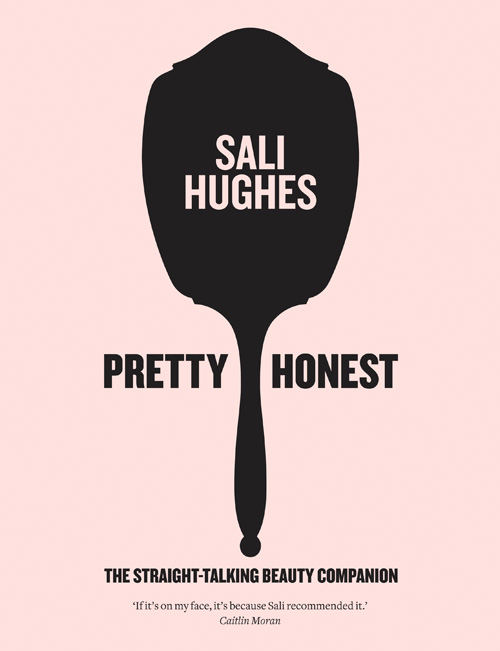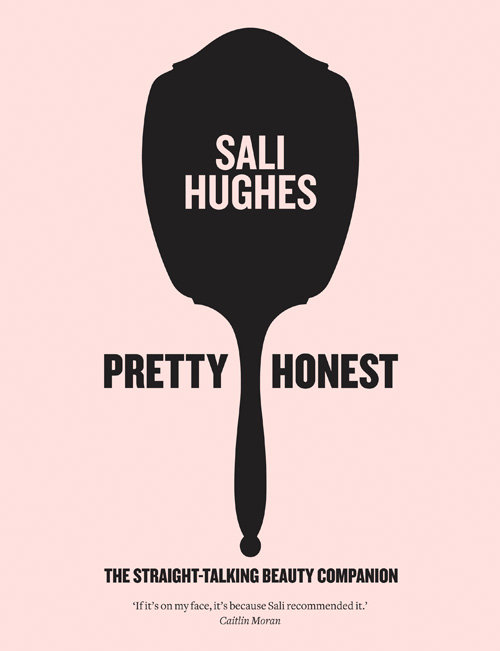Summer is officially here.
And with it, the ever-present ice-cream jingle coaxing you out of the house, and sprawling, semi-clad bodies on yellowing patches of grass.
Glorious, right?
For so many of us, summer is about confronting our lack of confidence in our bodies, and the prospect of taking off our protective armour of clothing is actually quite terrifying.
Sali Hughes to the rescue, with this handy, straight-talking and utterly sensible edited extract from the chapter ‘Showing Some Skin’.
You can find Sali’s suggestions for conditions such as Vitiligo and Ichthyosis in the chapter in full, from her book, Pretty Honest: The Straight-Talking Beauty Companion, out now.
SHOWING SOME SKIN
‘Even I don’t wake up looking like Cindy Crawford.’
Cindy Crawford
If you’re one of those women who happily wears vest tops while your smooth shoulders get darker and darker, or bares your legs as soon as the weather allows, then all power to you. If you can step out of the shower and straight into your work clothes without a 20-minute basting session with cream that feels like beef dripping, or wouldn’t know an ingrown hair if it sprang from the centre of your face, then congratulations – you are winning. Perhaps your white skin turns brown in the summer and flushes healthily in the winter, or your black skin turns golden on the beach, never ashy in the cold. If this is you, then skip this chapter. What follows is for the rest of us – the women who live in black opaques and spend hours surfing the net in search of frocks with proper sleeves.
I suppose that if I could change anything about my appearance I would swap the skin on my body. I was diagnosed with a hereditary skin complaint called Ichthyosis at birth. It’s a genetic condition that results in very dry skin cells that turn over and shed more rapidly than usual, causing flakiness and significant discomfort. It’s high maintenance and sometimes grim, but for all the misery it caused in childhood, I’ve latterly come to realise that I owe my dad’s dodgy skin quite a lot.
My obsession with improving my condition from the age of seven onwards caused NHS consultant dermatologists to discharge me at just 11 on the grounds that they ‘couldn’t do any better’ than I was doing myself, and has, without question, led me down my specific career path. I was forced from an early age to ‘get under’ my skin, find out what makes it tick, when it responds to treatment and changing conditions and how it can be cheated into looking a whole lot better. One of the most satisfying parts of my job is having the privilege of passing on what I’ve learnt to fellow sufferers of problem skin, or those who have children with a skin condition they’re struggling to understand.
I should say that the following is not a substitute for proper medical advice, not at all. You must ask your GP for a dermatologist referral if your skin condition is making life difficult. Truly, these men and women can work wonders and you should follow their advice. But I know from experience that most will be in agreement with me that as a long-term sufferer of any skin condition, you are your own skincare expert. No one, including the medics, will come to understand your skin better than you will, and certainly not how to live with it day to day. Listen to what it’s telling you and don’t be afraid to tell your doctor when you think you know better. A good one will listen and take note.
From chronic eczema and acne to everyday dry, pasty legs or pimply upper arms, I can help you. Cellulite creams and bust gels? They can’t and won’t work, and I’ll explain why. Don’t spend another summer sweating in black opaques. I can give you skin worth baring.
PASTY WHITE LEGS/VISIBLE VEINS
Tell a person you have lily-white or blotchy legs and they’ll tell you to apply self-tan – and if you can do so successfully, great. The key is to first scrub dry skin thoroughly (doing this to wet skin wastes product and works nowhere near as well), then rub body cream into dry areas that will take too much colour (knees, ankles, palms). When you’ve finished, don’t wash your hands; you will much more effectively stop staining by massaging in rich, almost greasy hand cream then wiping your hands thoroughly on a towel you don’t much care about.
If, like me, you don’t like self-tan (I am literally immune to its active ingredient), then buy some wash-off tan, which in my opinion looks much more natural and is far easier to apply. The best are by Fake Bake, DuWop, MAC, Sally Hansen and James Read Tan. Start with clean, dry limbs without applying any body lotion or cream (body lotion will cause it to streak and transfer onto clothes). Apply the tan sparingly, in layers, with your hands (or tanning mitt if you prefer). Allow to dry for a few minutes before dressing. Wash off in your next shower.
ASHY LIMBS
Problem
Dark skins are prone to greyness and a dull finish, especially in winter months. Skin can look a bit like it’s behind a sheet of tracing paper.
Treatment
What you need is an alpha hydroxy acid, delivered in scrub or body cream form (or even both). This will gobble away the dead cells that make the skin’s surface uneven and grey. It needs doing regularly in most cases – a couple of times a week at least, if not daily. Don’t make the mistake of assuming cocoa butter or another moisturiser will work as well; it will provide a quick fix by gluing down any flakes, but you’ll be back to square one by bedtime.
CELLULITE
Problem
Orange-peel dimples on thighs, bum, knees or upper arms. I hesitate to call this a problem since every woman I know has cellulite somewhere or other. Equally, I know not a single man who could identify it if his life depended on it, much less take objection to it. Nonetheless, if you want to disguise it…
Treatment
Do not buy a cellulite cream, gel or any fangled contraption for ‘zapping’ the dimples. I’m sorry to tell you, but in my opinion they simply cannot work. Cellulite is the outward appearance of fat cells. Nothing topical can burn fat cells. This is a nonsensical idea that is costing women billions in wasted cash. Don’t get sucked into it.
If you want to improve the appearance of cellulite, the best way is to make your skin as smooth as possible through exfoliation. Get yourself a robust salt scrub for the body. You don’t need an expensive one, but make sure it’s not one with ‘beads’ in it. They are useless; you want big, rough flakes of salt. Massage the affected areas rigorously before you enter the shower. Rinse off under the water. Follow with either moisturiser or, for maximum cellulite flattery, wash-off tan (see above).
ECZEMA
Problem
Red weals and dry, sore patches on the body. Often seen on inner arms, behind the knees and around ankles.
Treatment
Sadly, there is no fix, only good skin management. You must in the first instance see your GP and get a referral to a dermatologist for expert diagnosis (there are several different types of eczema, including seborrhoeic and contact dermatitis) and appropriate treatment. If a flare-up is particularly extreme, s/he will probably prescribe topical steroids, which are very effective in the short term but should not be used for a long time as they cause damage to the skin. You’ll also get emollients for washing and applying to dry skin afterwards. Having been on the receiving end of many of these prescription creams for many years, I will say that I find them less effective than great-quality creams made by non-pharmaceutical brands. This, I believe, has more to do with cost and budgetary restrictions than the genuine belief of well-meaning derms that these greasy, mineral-oil-rich lotions are actually the best thing. But that is only my opinion as a long-term NHS derm patient who comes from a pro-science and largely pro-chemical stance.
This is one of the few instances where I feel natural products can often be much more effective. What I like are shower and body creams containing avocado, olive or almond oil. These don’t need to be expensive (I’ve bought them from the groceries section and simply poured them into simple body creams before now). I also like shea butter, which can be bought inexpensively from most high street pharmacies. All are very emollient and form a good barrier against the elements. I also like creams containing hyaluronic acid as they tend to leave skin more supple and less uncomfortable. Steam rooms can also be extremely helpful, only in short bursts of 5–10 minutes though. There’s evidence to suggest than eczema patients are more likely to be deficient in vitamin E, though the jury is still out on whether supplements will help. I would take them anyway.
There are heaps of things you can do to prevent serious eczema outbreaks. One should always wear hypo-allergenic gloves for housework and washing up, avoid excessive consumption of dairy (I know, cheese. Life is extremely unfair), and use very, very gentle cleansing products, avoiding acids and retinoids. Don’t swim in chlorinated pools without plenty of barrier cream and use only unscented body washes, never soap. Pure cotton clothing is less irritating than man-made fibres and stress is to be avoided, but isn’t it always? Easier said than done, of course.
To cover eczema breakouts, follow my instructions for vitiligo, but be kind to your skin and give it plenty of days off.
PSORIASIS
Problem
Psoriasis is believed to result from a fault in the immune system. Its effect is not a million miles from ichthyosis, as cells turn over too rapidly (healthy skin cells replace themselves in 3–4 months; psoriasis suffers get new ones every 3–7 days). The result is a sort of backed-up crust of skin cells, causing itchiness, redness and soreness.
Treatment
Psoriasis is often triggered by illness, infection or stress, so keeping well is the best preventative measure. Cold weather also seems to exacerbate it so wrap up warm, wearing cotton tights (lycra seems to be fine for sucky-inny purposes), rather than nylons. Always moisturise straight after showering with a rich barrier cream. Shea butter seems to be particularly good and is, in my opinion, more soothing than prescription creams. I also think shaving with a sharp razor helps, provided the scales aren’t tender and painful. To cover psoriasis scabs for a special occasion, follow the instructions for vitiligo, but begin with a coating of brow wax to create a smooth, waxy surface, available from professional stores (see Specialist Shops).
BUMPY UPPER ARMS
Problem
Bumpy upper arms (Kerastosis pilaris) are very common and are thought to be connected to poor circulation and sluggish skin cell turnover. The arms are also often red, making the wearing of sleeveless frocks a bit undesirable.
Treatment
These can be drastically improved or fixed with good, regular exfoliation. Use a good body scrub containing alpha or beta hydroxy acid before every shower in the run up to a special occasion (brides in sleeveless dresses should start several months before the wedding). Moisturise immediately after showering with an AHA or BHA body lotion or serum (Palmer’s and Clarins make brilliant ones). Apply again before bed and even during the day if you can find either the time or inclination. Even out any remaining redness by stroking on wash-off tan or body make-up (MAC makes a brilliant body foundation in every skin tone, from light to dark).
INGROWN HAIRS
Problem
Hairs that fail to emerge from their follicle, growing inwards and leaving bumps and pimples on the surface of the skin.
Treatment
Ingrown hairs are very common in women who wax and shave (and also in men). They result usually from the follicle surrounding them becoming covered with either swollen or dead skin. The way to prevent them is through proper exfoliation with a good scrub, applied to dry skin then washed off in the shower. A body lotion containing alpha hydroxy acid will also help prevent and, to some degree, treat them (though neither should be done immediately after epilation). If the ingrown hair is too set in, then you must remove it physically with tweezers. Everyone should own a super-sharp pair with a slanted edge – I favour Rubis, though Tweezerman are also excellent. Cheap tweezers are always useless and are as much good as a wooden spoon for the purpose. To remove an ingrown hair, exfoliate first and pat skin dry to avoid slip. Take the tweezers and gently scrape away the top layer of dead skin until the hair is exposed. Then, using the sharp tip, pluck – a good pair of tweezers will make light work of this. This is deeply satisfying and gratifying. Frankly, I almost feel sad when several months pass without the opportunity to perform this basic surgery.
Liked this?
 Read Sali on date make-up and the morning after, or her introduction to Pretty Honest.
Read Sali on date make-up and the morning after, or her introduction to Pretty Honest.



